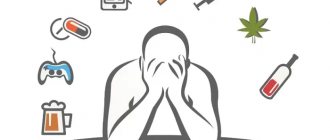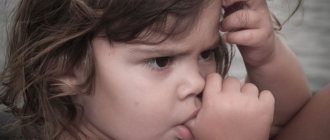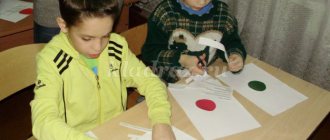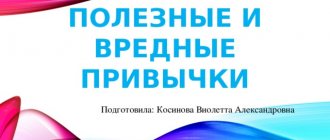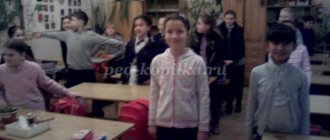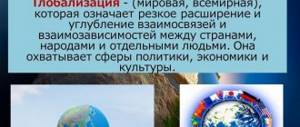Lesson summary of the surrounding world in 4th grade. Bad habits
Lesson on the surrounding world in 4th grade Topic: Let's talk about bad habits
Author: Nadezhda Vladimirovna Ryabichenko, primary school teacher at the MKOU "Mikhailovskaya secondary school" in the Kikvidzensky district of the Volgograd region. Description of the material: This material is intended for primary school teachers working on the educational and methodological complex “Primary School of the 21st Century”. The lesson was conducted with 4th grade students on November 20, 2014, International No Smoking Day. Goal: developing children’s knowledge and ideas about bad habits. Objectives: Subject : - to form an idea of the harmful effects of smoking, alcohol, and drug use on the human body; — develop the ability to work with various sources of information: textbook, additional literature; -improve the ability to use information and communication technologies. Personal: - to form a value-based attitude towards one’s health, the need to lead a healthy lifestyle. Meta-subject: - to form the cognitive interests of students; — to create the need to acquire new knowledge and practical skills; — continue to develop the ability to organize one’s activities, determine its goals and objectives, and evaluate the results achieved; — develop the ability to independently search, analyze and select information; — promote awareness of the possibility of widespread use of information and communication technologies to study the world around us; — continue to develop the ability to work in a team, the ability to realistically assess one’s capabilities; - develop oral speech. Equipment: excerpts from the cartoon “Pipe and the Bear”, computer, screen, projector, exhibition of books, drawings of red and green balls, cards with notes on what is useful and harmful for the human body, cards with tables to fill out.
Lesson progress:
I. Organizational moment. — Guys, today I came to you in a good mood. There are guests at our lesson. Let's greet them warmly and thank them with a smile for coming to us. I hope you remain in a good mood until the end of the lesson. Today in class we will discuss a topic that is very important for every person. And you will find out what we will talk about a little later. In our time, a time of technological progress, environmental disasters, what do you think is most valuable to us? (Children's answers). - Of course, health! Human health is the main value in life. You can't buy it for any money. When a person is sick, he will not be able to realize his dreams, will not be able to devote his strength to overcoming life’s challenges, and will not be able to fully realize himself in the modern world. II. Fixing the problem, formulating the topic, lesson goals. — Let’s watch an excerpt from the cartoon “How the Bear Smoked a Pipe” and answer the question: Why is the bear cheerful, joyful, cheerful? (turn on from 1 minute 05 seconds to 2 minutes 25 seconds) - So, why is the bear cheerful, joyful, cheerful? (he is healthy, leads a healthy lifestyle: he does exercises in the morning, breathes clean air, and hardens himself). — Watch another excerpt from the same cartoon and think: What has changed? What did the bear become? (turn on from 4 minutes 28 seconds to 5 minutes 19 seconds) - What happened to the bear? (he began to cough, lost weight, hair is coming out, his bones are aching, his heart is aching, his paws are trembling) - Why? (Because he smoked) - So that's why he became like that. It's all because of a bad habit! Guys, we have already talked about the rules of a healthy lifestyle. What do you think we will talk about today? (about bad habits). What bad habits do you know? (alcohol, drinking, drug use). Children can name other bad habits. So, the topic of our lesson: “Let's talk about bad habits” - What do you think is the purpose of our lesson? (Find out how bad habits affect human health). “And today I propose that you work according to this plan.” 1. Set the mood for the lesson.
2. Bad habits: 2.1. Tobacco smoking. 2.2. Alcoholism and drug addiction. 3. Summing up. We have already received the mood for the lesson.
We found out what we will talk about today in class. Next, let's talk about bad habits, find out how smoking, drinking alcohol and drugs affect the human body. And, of course, we will summarize our lesson and find out whether you learned something new or not. Does this matter to you personally or not? III. Discovery of new knowledge. 1) Teacher's introduction
Discoveries and innovations are not always beneficial.
Here is the “gift” of the American continent - tobacco, which has firmly conquered the whole world, is far from a harmless hobby. For many years, miraculous and even medicinal properties were attributed to tobacco and its smoking. Only after 1950 did research results become known showing how harmful and dangerous tobacco smoking can be. — Guys, do you know that today, November 20, is International No Smoking Day. Nam (student's name) prepared a short message about this day. 2) Message:
There are two international days on Earth dedicated to the fight against smoking - World No Tobacco Day (May 31) and International No Smoking Day, which is celebrated annually on the third Thursday of November.
This year it is celebrated today, November 20th. International No Smoking Day was established in 1977 by the decision of the American Cancer Society with the support of the World Health Organization. In May 2003, the World Health Organization adopted an international treaty on tobacco control, which was joined by more than 90 countries, including Russia. The purpose of International No Smoking Day is to attract public attention to the negative consequences of smoking tobacco. — Guys, for what purpose was International No Smoking Day established? (The purpose of International No Smoking Day is to help reduce the prevalence of tobacco dependence, prevent tobacco smoking and educate the public about the harmful effects of tobacco on health). 3) Work on the topic
2 students read the text of the textbook “Smoking is dangerous to health” on pages 72, 73 2 students read the text about the dangers of smoking on pieces of paper (taken from the Internet):
Tobacco smoking is very common among the population of all countries.
In Europe, approximately 215 million people are smokers, of which 130 million are men. Smoking is one of the most common causes of death, as cigarette smoke contains about 800 harmful substances. Smoking is clearly associated with the development of lung cancer, many chronic diseases of the lungs, digestive system, heart, promotes damage to blood vessels, upper and lower extremities, causes sudden death, and significantly reduces the duration and quality of life of the smoker and his loved ones. Long-term smoking not only leads to the fact that a person often gets sick, but his performance, attention and physical endurance decrease, memory, attention, hearing deteriorate, fatigue increases, and the number of mistakes made increases. This is why people who smoke are often unable to achieve high results in life. They often have conflicts with those who do not smoke; Moreover, they often also become unattractive: the color of their teeth changes, their skin becomes gray and yellow, and their eyes become dull. Questions: 1. How many harmful substances are contained in cigarette smoke?
(about 800) 2. Which is the most harmful of them? (nicotine) 3. What happens under the influence of nicotine? (heart function weakens, blood pressure rises) 4. What changes occur in the lungs of a smoker? (contaminated) When cigarette smoke passes through the mouth and respiratory tract, it settles in the lungs in the form of tar. The resin then irritates the airways, causing germs and dirt to remain in the lungs. 5. What harm does smoking cause to the human body? (Diseases of the lungs, heart, stomach, and liver appear, the most terrible of which is cancer. Memory and attention deteriorate, resistance to disease decreases, and teeth turn yellow). - Do you know what happens if someone smokes and you are nearby? (We inhale some of the tobacco smoke. We become passive smokers, and we also poison our body). Teacher: Passive smoking is a condition when non-smokers are forced to breathe tobacco smoke while being near smokers. Secondary smoke, which is exhaled by a smoker, pollutes the air with nicotine, tar, radioactive substances and other harmful components. Researchers on passive smoking have concluded that in a poorly ventilated room, a non-smoker inhales the same amount of smoke in 1 hour as a smoker gets from one cigarette. — What can you do if someone smokes nearby? (ask not to smoke or leave the room yourself) - What conclusion can we draw about smoking? (harmful to health) 4) Physical exercise.
We've worked hard - let's rest!
Let's stand up, take a deep breath, Arms to the sides, forward, Left, right, turn. Three bends, stood up straight, hands up and down. They lowered their hands smoothly and gave everyone smiles. Well done! — Let's move on to the next stage. What will we learn about? (about the influence of alcohol and drugs on the human body) 5) Work in pairs.
1 pair - Read the text in the textbook on pp. 73, 74 “Caution - alcohol” 2 pair - Read the text in the textbook on pp. 74, 75 “Fun that leads to death”
Fill out the table:
— Guys, you will work in pairs. Let's remember the rules of work 1. When working, listen carefully, look at the interlocutor. 2. Speak quietly, do not disturb others. 3. You need to be able to agree with each other who will fill out the card, who will help, and who will then give a message. Check (an example of filling out the table):
— What effect does alcohol and drugs have on the human body? (Destructive) Exercise for the eyes
Here stands the autumn forest!
It contains many fairy tales and miracles! (Perform circular movements with the eyes) On the left are pine trees, on the right is oak. (Perform eye movements left and right) Woodpecker from above - knock, knock, knock. (They move their eyes up and down) Close your eyes, open them, and quickly run home! IV. Application of new knowledge in creative works. 1. Game "Balloons". We continue to work. Let's play the game "Balloons". (there are 2 drawn balls on the board, red and green)
Rules of the game: Imagine that a red balloon contains everything useful for a person, helping him grow healthy, beautiful, happy, and a green balloon contains everything harmful that prevents a person from growing healthy and leads to illness. I have cards on my desk with notes on what is useful and what is harmful to humans. You will come to me now. 1 pair must “fill” the red ball, the second pair must fill the green one (add tape to each card in advance). Useful:
physical activity, balanced nutrition, hardening, personal hygiene, positive emotions, giving up bad habits, maintaining a daily routine.
Harmful:
smoking, alcohol consumption, drug use, sedentary lifestyle, overeating, non-compliance with the daily routine. 2. Working with fillword.
- Find words related to the topic of our lesson.
Words:
alcoholism, smoking, drug addiction - Make a new word from the remaining letters. (Evil)
— Are alcoholism, drug addiction, and smoking really evil?
Why? V. Reflection. Lesson summary. — Guys, what was the purpose of our lesson today? - Have we reached it? — You have cards of different colors on your desks. If you were interested in today's lesson, you understood everything and can tell others about it, raise your green card. If you were interested, but did not understand everything, pick up the orange card. And if you were not interested in the lesson, you did not learn the material well, raise the blue card. — What new things did you learn for yourself while working in class? — What advice would you give to other guys? — What conclusion did you draw from today’s lesson? (You cannot smoke, drink alcohol, or use drugs. This is harmful and dangerous to health.) In front of each of you on pieces of paper lies your ladder of success. Evaluate your work in class, draw a smiley face on the step that each of you climbed today.
Self-assessment Lesson grades VI. Homework 1) Page 25 notebooks No. 72, No. 73 2) Bring pictures, articles from newspapers, magazines, about bad habits. Used literature: Vinogradova N.F., Kalinova G.S. The world around us. Textbook for 4th grade, part 1 - Moscow, Ventana - Graf, 2013. Internet resources.
We recommend watching:
Test on the topic: Life of the ancient Slavs, 4th grade The world around us Integration of general and additional education for the implementation of the national-regional component n Integrated lesson “Social groups in the world of people” on the subject “The world around us”, 4th grade Lesson of the surrounding world in 4th grade. The surface of our region
Similar articles:
Lesson summary of the world around us, grade 4 according to the “School of Russia” program
Extracurricular activity on the surrounding world, 4th grade
Olympiad tasks on the surrounding world, grades 3 - 4
Poems about the world around us, grade 4
Lesson summary. The world around us, 4th grade. The world through the eyes of an astronomer. School of Russia
